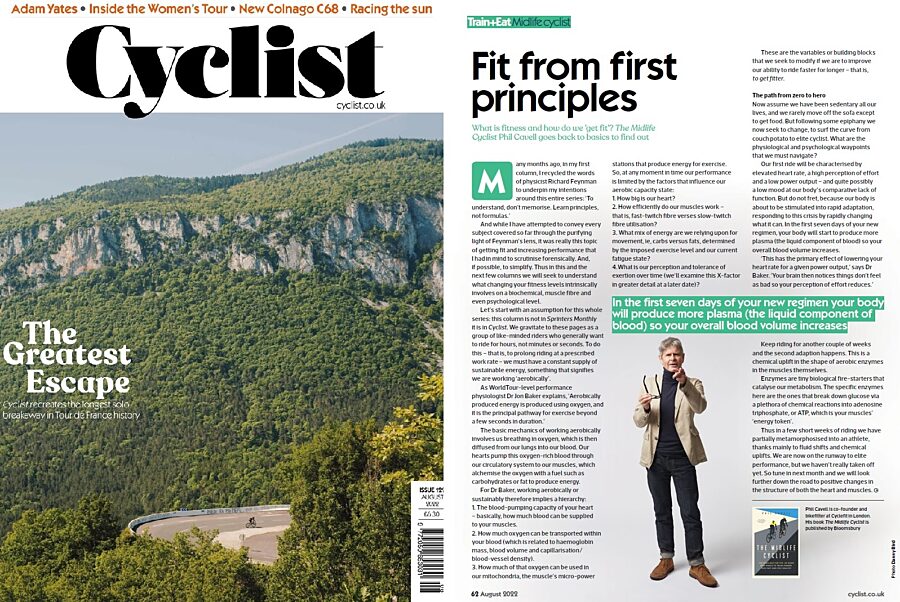"Aerobically produced energy is produced using oxygen, and it is the principal pathway for exercise beyond a few seconds in duration"
Fit From First Principles
Many months ago, in my first column, I recycled the words of physicist Richard Feynman to underpin my intentions around this entire series:
‘To understand, don’t memorise. Learn principles, not formulas.’
And while I have attempted to convey every subject covered so far through the purifying light of Feynman’s lens, it was really this topic of getting fit and increasing performance that I had in mind to scrutinise forensically. And, if possible, to simplify. Thus in this and the next few columns we will seek to understand what changing your fitness levels intrinsically involves on a biochemical, muscle fibre and even psychological level.
Let’s start with an assumption for this whole series: this column is not in Sprinters Monthly it is in Cyclist. We gravitate to these pages as a group of like-minded riders who generally want to ride for hours, not minutes or seconds. To do this – that is, to prolong riding at a prescribed work rate – we must have a constant supply of sustainable energy, something that signifies
we are working ‘aerobically’. As WorldTour-level performance physiologist Dr Jon Baker explains:
‘Aerobically produced energy is produced using oxygen, and it is the principal pathway for exercise beyond a few seconds in duration.’
The basic mechanics of working aerobically involves us breathing in oxygen, which is then diffused from our lungs into our blood. Our hearts pump this oxygen-rich blood through our circulatory system to our muscles, which alchemise the oxygen with a fuel such as carbohydrates or fat to produce energy.
For Dr Baker, working aerobically or sustainably therefore implies a hierarchy:
- The blood-pumping capacity of your heart – basically, how much blood can be supplied to your muscles
- How much oxygen can be transported within your blood (which is related to haemoglobin mass, blood volume and capillarisation/blood-vessel density).
- How much of that oxygen can be used in our mitochondria, the muscle’s micro-power stations that produce energy for exercise.
So, at any moment in time our performance is limited by the factors that influence our aerobic capacity state:
- How big is our heart?
- How efficiently do our muscles work – that is, fast-twitch fibre verses slow-twitch fibre utilisation?
- What mix of energy are we relying upon for movement, ie, carbs versus fats, determined by the imposed exercise level and our current fatigue state?
- What is our perception and tolerance of exertion over time (we’ll examine this X-factor in greater detail at a later date)?
These are the variables or building blocks that we seek to modify if we are to improve our ability to ride faster for longer – that is, to get fitter.
"In the first seven days of your new regimen your body will produce more plasma (the liquid component of blood) so your overall blood volume increases"
The Path from Zero to Hero
Now assume we have been sedentary all our lives, and we rarely move off the sofa except to get food. But following an unspecified epiphany we now seek to change, to surf the curve from couch potato to elite cyclist. What are the physiological and psychological waypoints that we must navigate? Our first ride will be characterised by elevated heart rate, a high perception of effort and a low power output – and quite possibly a low mood at our body’s comparative lack of function. But do not fret, because our body is about to be stimulated into rapid adaptation, responding to this crisis by rapidly changing what it can.
The First Seven Days
In the first seven days of your new regimen, your body will start to produce more plasma (the liquid component of blood) so your overall blood volume increases.
‘This has the primary effect of lowering your heart rate for a given power output,’
says Dr Baker.
‘Your brain then notices things don’t feel as bad so your perception of effort reduces.’
The First Few Weeks
Keep riding for another couple of weeks and the second adaption happens. This is a chemical uplift in the shape of aerobic enzymes in the muscles themselves. Enzymes are tiny biological fire-starters that catalyse our metabolism. The specific enzymes here are the ones that break down glucose via a plethora of chemical reactions into adenosine triphosphate, or ATP, which is your muscles’ ‘energy token’.
Thus in a few short weeks of riding we have partially metamorphosised into an athlete, thanks mainly to fluid shifts and chemical uplifts. We are now on the runway to elite performance, but we haven’t really taken off yet. So tune in next month and we will look further down the road to positive changes in the structure of both the heart and muscles.
Phil Cavell is co-founder and bikefitter at Cyclefit in London. His book The Midlife Cyclist is published by Bloomsbury. This Column was first published in Cyclist Magazine - August 2022 and is re-printed here with their kind permission.


